RARE! WWII 1945 Original World War II “Headquarters of the Commander in Chief - U.S. Pacific Fleet” CONFIDENTIAL Operation Iceberg Okinawa Gunto Invasion Bulletin (Okinawa Surrounding Islands)


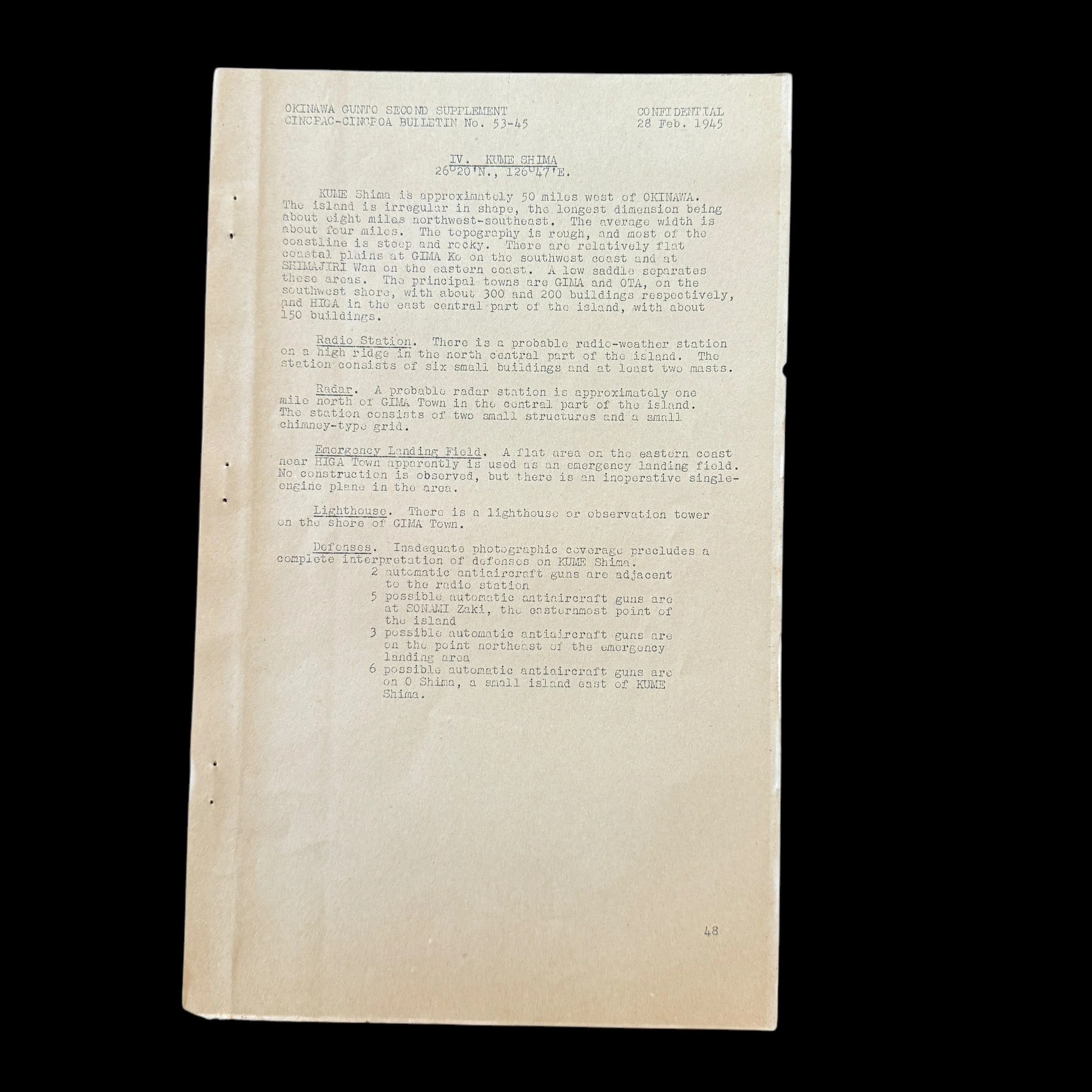
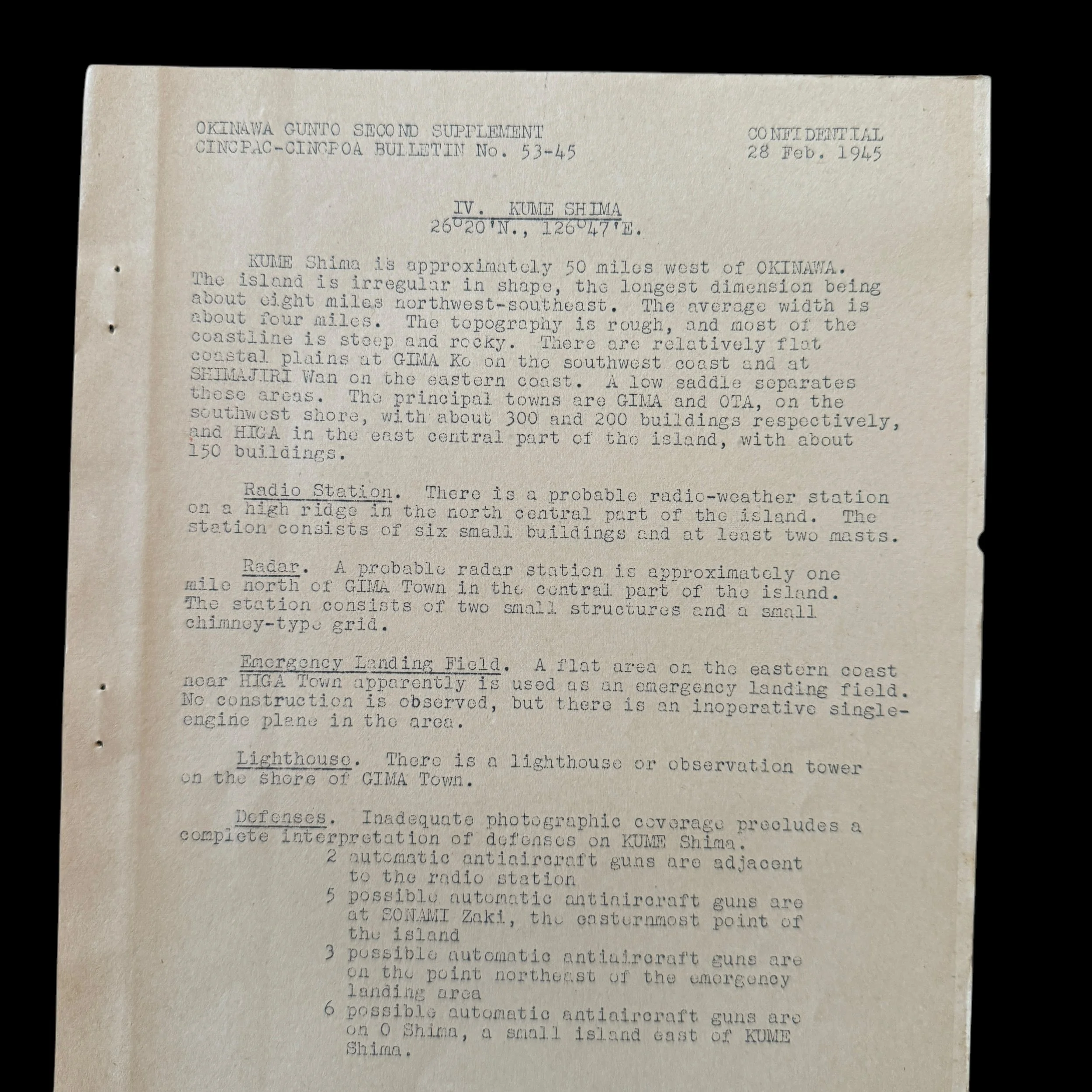
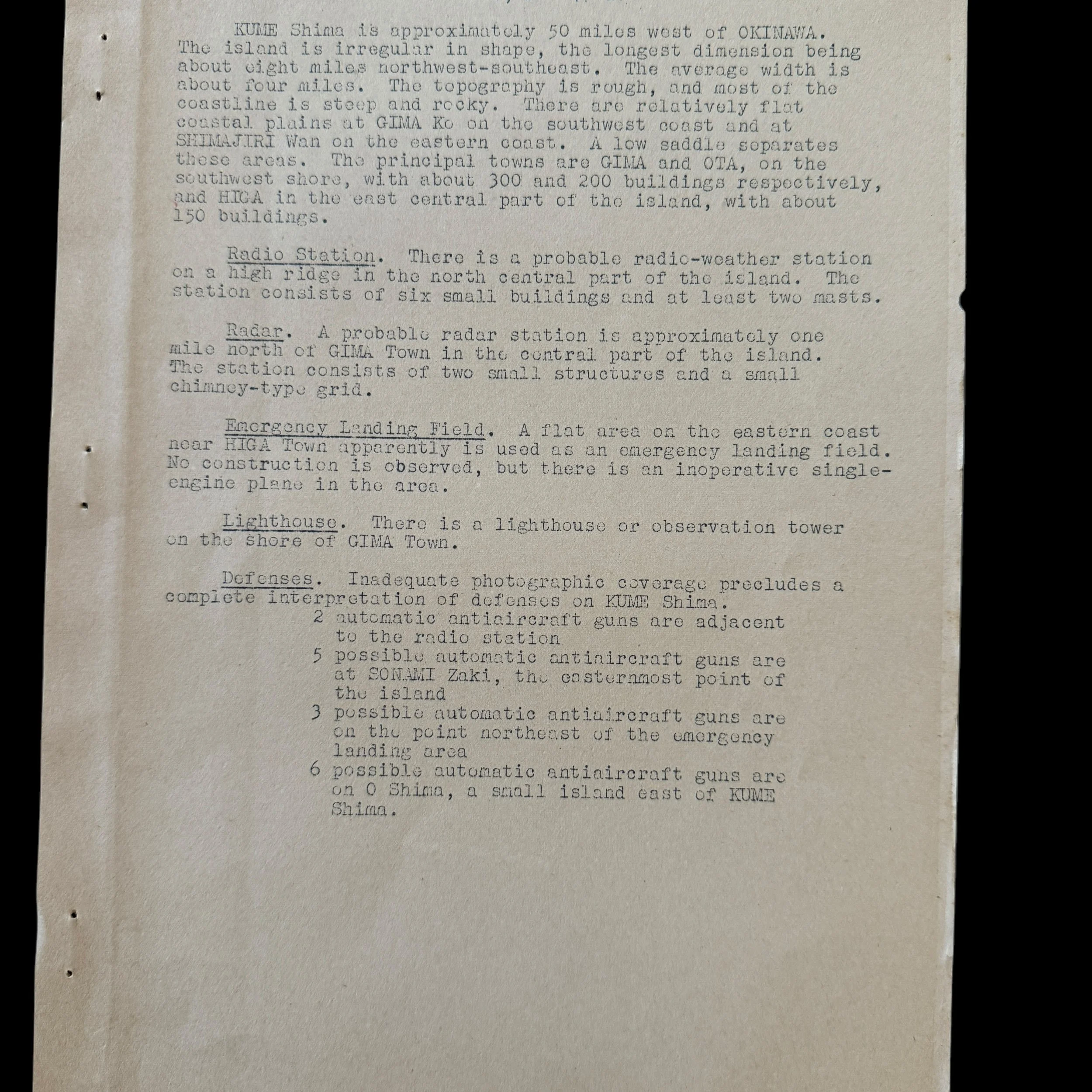
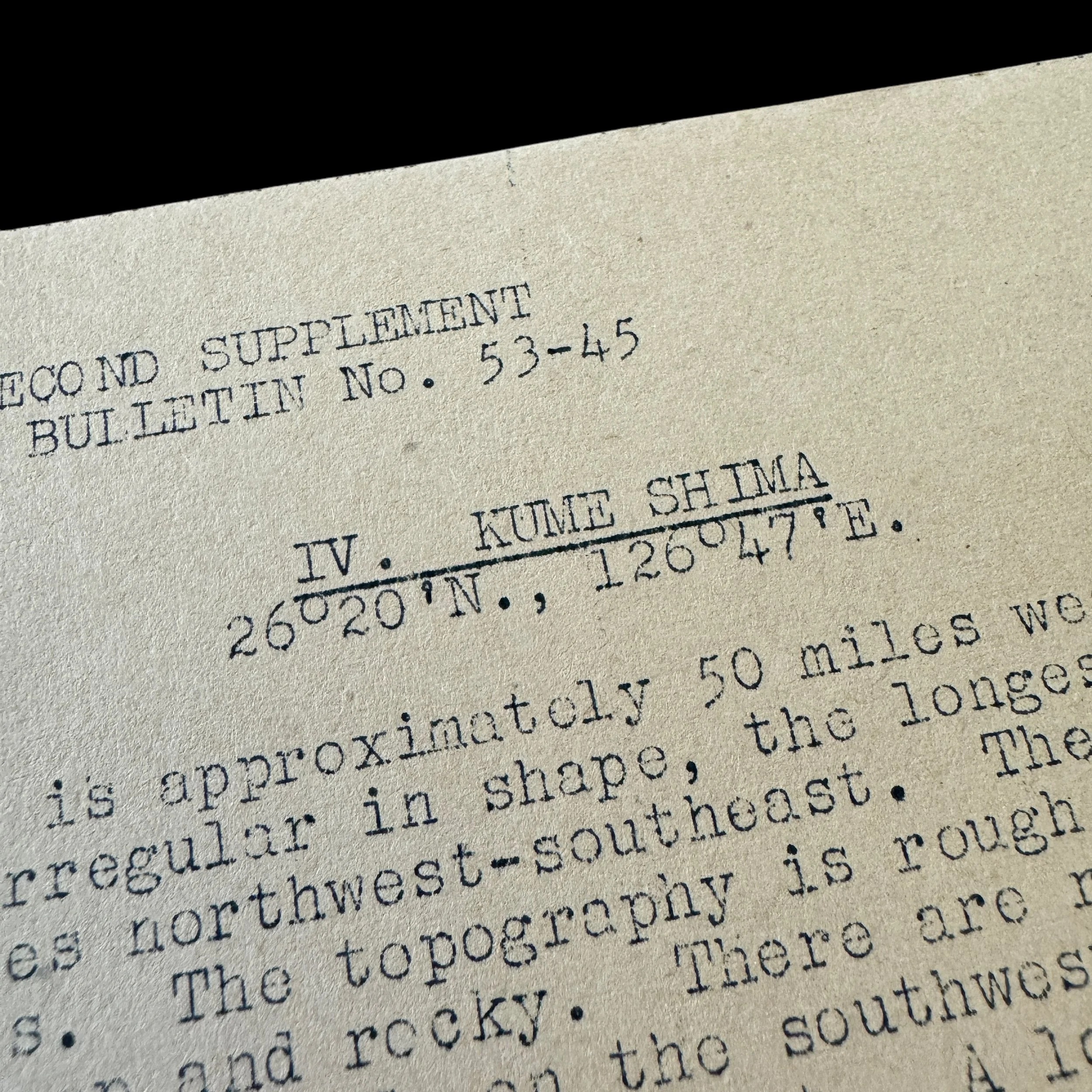


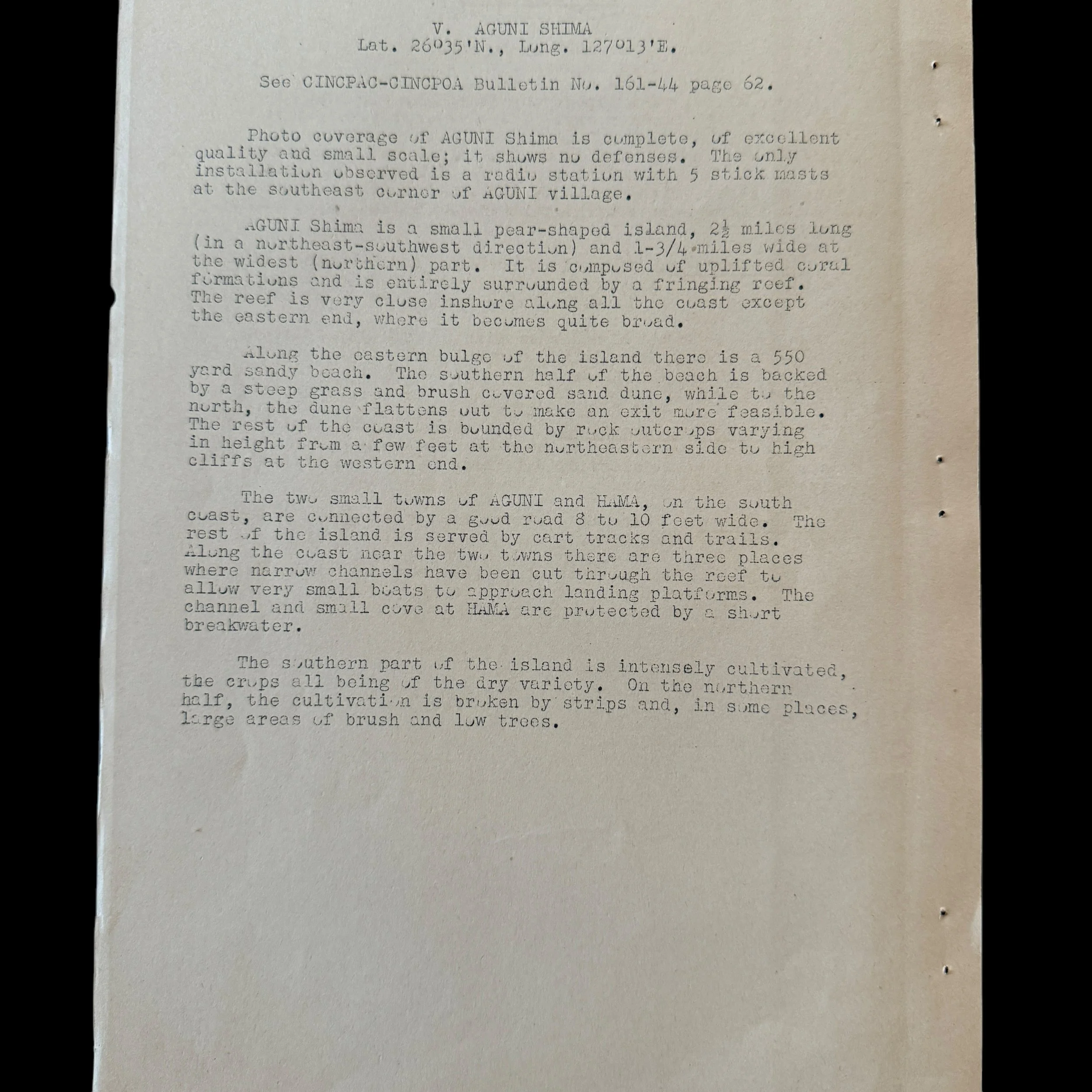
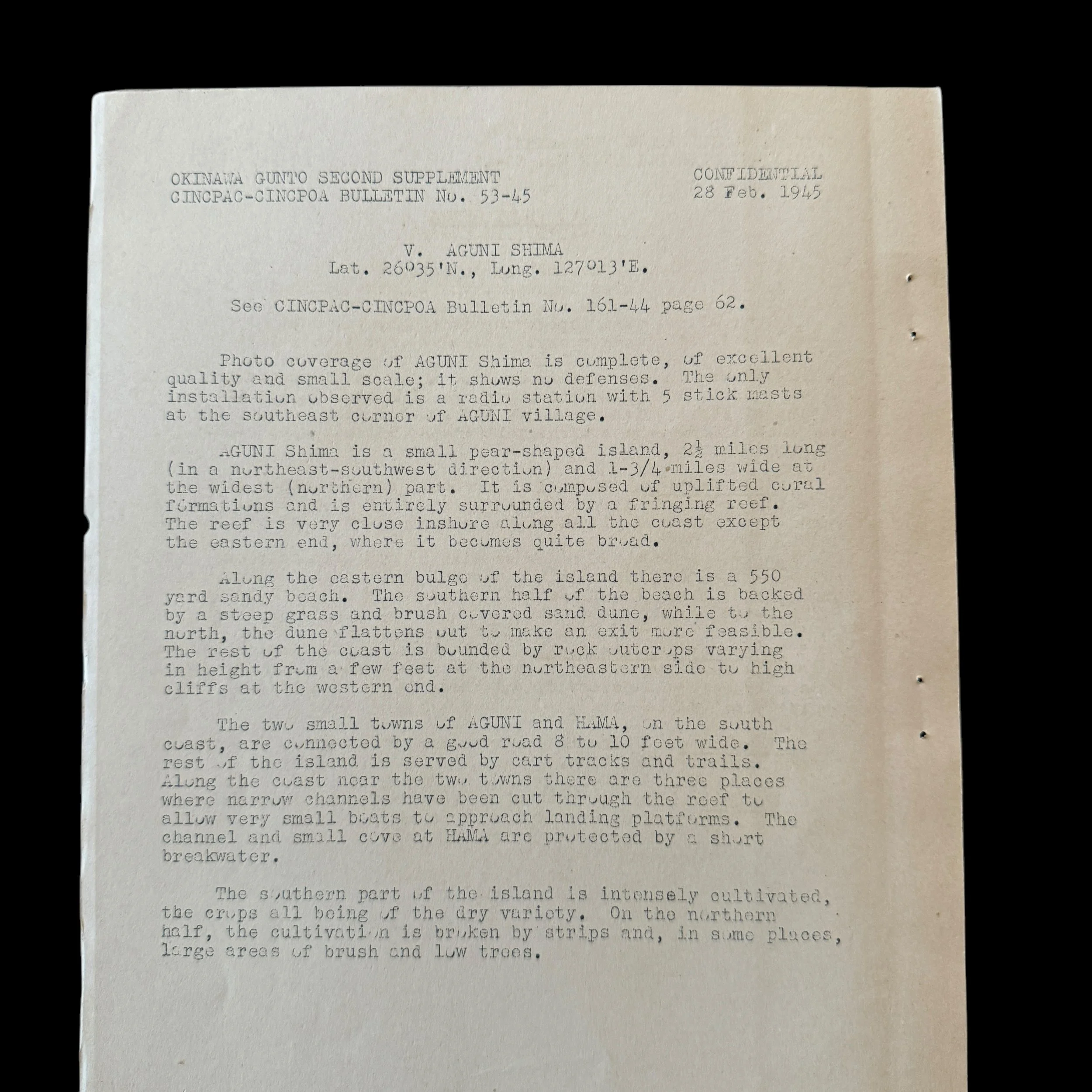
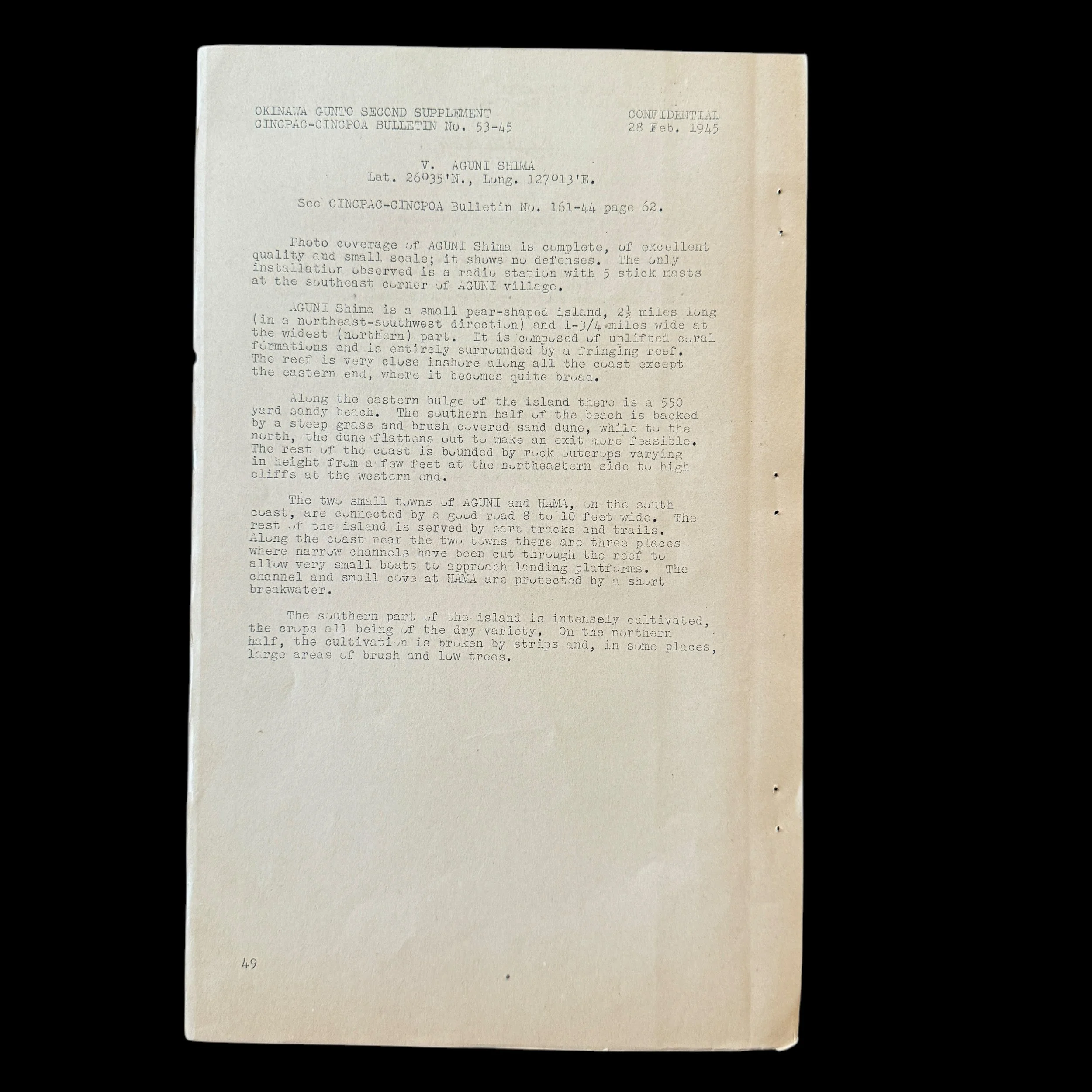
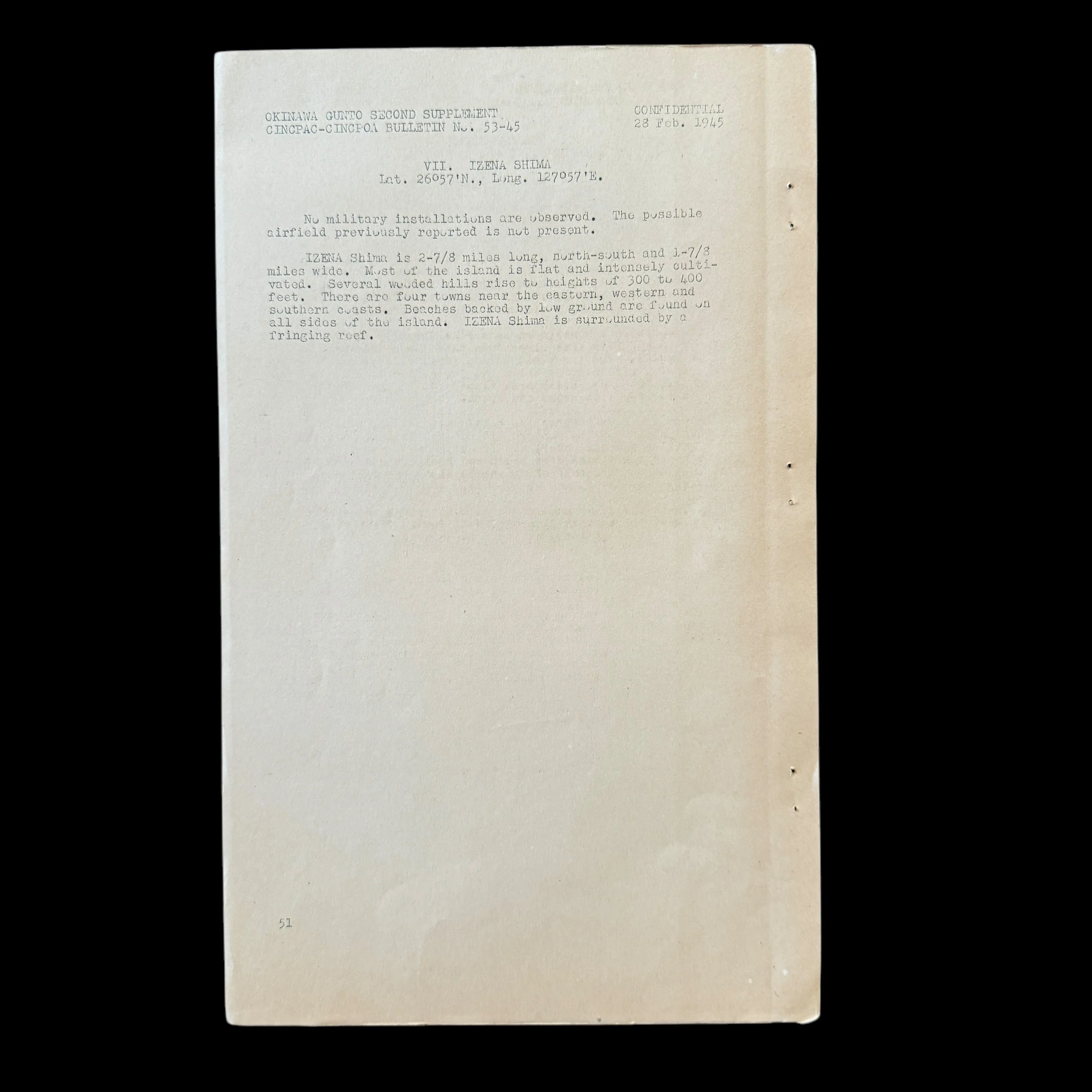
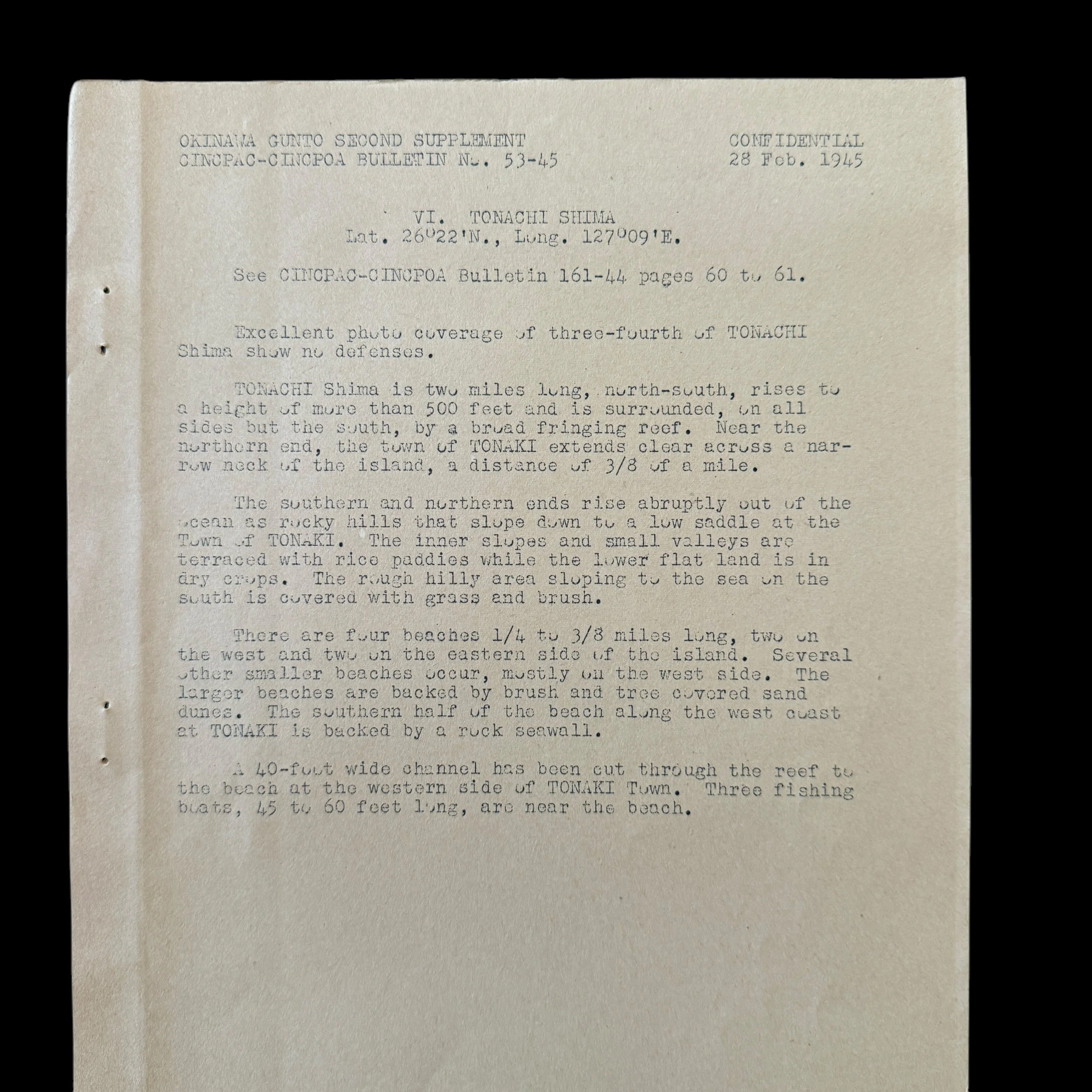

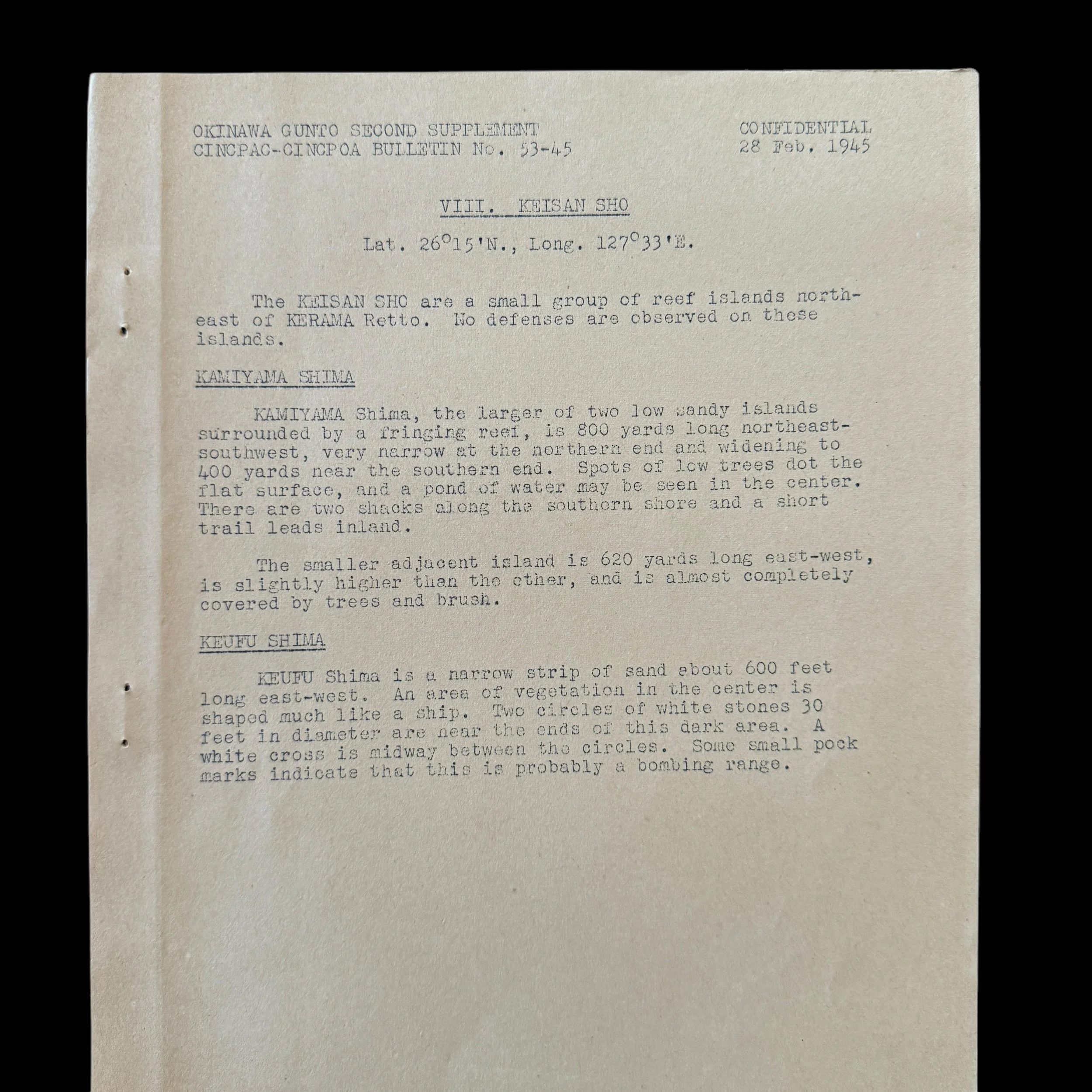


RARE! WWII 1945 Original World War II “Headquarters of the Commander in Chief - U.S. Pacific Fleet” CONFIDENTIAL Operation Iceberg Okinawa Gunto Invasion Bulletin (Okinawa Surrounding Islands)
Comes with hand-signed C.O.A. and a full historical write-up
Type: Original World War II “Headquarters of the Commander in Chief - U.S. Pacific Fleet” CONFIDENTIAL Operation Iceberg Okinawa Gunto Invasion Bulletin
Subject: Kume Shima, Aguni Shima, Tonachi Shima, Izena Shima, Keisan Sho, Keufu Shima, etc.
Campaign: Pacific Theater
Dated: Feb. 1945
Pages: 5 (double-sided) = 10 pages total
This rare, museum-grade World War II artifact is an original"Headquarters of the Commander in Chief - U.S. Pacific Fleet" CONFIDENTIAL Operation Iceberg Okinawa Gunto Invasion Bulletin.Produced in extremely limited numbers—fewer than 500 copies produced in 1945—these highly classified bulletins were reserved exclusively for the highest-ranking generals, officers, and intelligence officials directly involved in planning and executing the Okinawa campaign in April 1945.
Operation Iceberg, the largest amphibious assault in the Pacific Theater, required an unprecedented level of preparation and intelligence gathering. This invasion bulletin exemplifies the meticulous planning that defined the campaign, containing detailed intelligence on Japanese defensive positions and the expected strategy for Okinawa and nearby Ie Shima.
The bulletin underscores the gravity of the operation, as Okinawa was strategically critical for its proximity to the Japanese mainland. This document served as a cornerstone for the Allied effort, guiding military leaders in orchestrating the assault, which would become one of the bloodiest and most consequential battles of World War II.
Today, this artifact stands as a testament to the complexity and scale of wartime planning, offering a rare glimpse into the intelligence and strategy that shaped one of the most pivotal moments of the Pacific campaign. Its historical significance and rarity make it a treasured piece of World War II history, capturing the monumental effort behind the Allied push toward victory.
The Battle of Okinawa: Estimated Japanese Dispositions and Targets for Kume Shima, Aguni Shima, Tonachi Shima, Izena Shima, Keisan Sho, and Keufu Shima
The Battle of Okinawa, fought from April 1 to June 22, 1945, was one of the most critical and intense campaigns of World War II. As the largest amphibious assault in the Pacific Theater, the campaign was not limited to Okinawa's main island but also involved securing control over surrounding islands, which played essential roles in Japanese defensive strategy. These islands, including Kume Shima, Aguni Shima, Tonachi Shima, Izena Shima, Keisan Sho, and Keufu Shima, served as observation points, staging areas, or logistical support hubs, while some were incorporated into Japan's broader defensive network.
1. Kume Shima
Strategic Importance:
Kume Shima, located about 55 miles west of Okinawa, was of considerable strategic value due to its proximity to the main island and its potential use as an airfield or naval observation post. It was critical for Japanese operations to monitor Allied movements in the region.
Japanese Dispositions:
Japanese forces stationed on Kume Shima were limited, consisting primarily of small garrisons from the 3rd Special Base Force and local militia units. The total strength was estimated at fewer than 1,000 troops.
The island's natural terrain, including hills and cliffs, was utilized to create defensive positions. Fortifications were minimal but included observation posts, machine-gun nests, and concealed artillery emplacements.
Kume Shima was also used as a site for early-warning operations to relay information about Allied naval and air activity.
Allied Operations:
The island was bypassed during the initial stages of the Okinawa campaign but was later captured by Allied forces to ensure it could not be used for Japanese reconnaissance or counterattacks. It also provided a potential staging area for Allied logistics.
2. Aguni Shima
Strategic Importance:
Located about 40 miles west of Okinawa, Aguni Shima held strategic importance as an observation and support location. Its position allowed Japanese forces to monitor Allied naval activity and provide early warnings for the defense of Okinawa.
Japanese Dispositions:
The Japanese garrison on Aguni Shima was small, numbering fewer than 500 troops, consisting primarily of lightly armed infantry and local militia.
The island’s defenses were rudimentary, relying on natural terrain features and scattered fortifications such as trenches and small bunkers.
Aguni Shima was believed to have a few anti-aircraft guns and light artillery pieces, likely intended to delay any Allied landings.
Allied Operations:
U.S. forces secured Aguni Shima without significant resistance, ensuring it could no longer serve as a Japanese observation post. The island's capture also eliminated a potential base for kamikaze or harassment operations.
3. Tonachi Shima
Strategic Importance:
Tonachi Shima, part of the Kerama Retto group, was targeted early in the campaign for its role in supporting Japanese naval operations, particularly the deployment of suicide boats (explosive-laden vessels designed to attack Allied ships).
Japanese Dispositions:
The garrison on Tonachi Shima consisted of approximately 200–300 troops, primarily from naval ground units tasked with operating and maintaining suicide boats.
Defensive positions included small bunkers, hidden boat shelters, and coastal artillery emplacements.
The Japanese sought to use the island as a base for launching suicide boat attacks on the Allied fleet during the Okinawa campaign.
Allied Operations:
Tonachi Shima was one of the first islands in the Kerama Retto to be assaulted by U.S. forces. The rapid capture of the island disrupted Japanese suicide boat operations and secured the area for Allied naval use.
4. Izena Shima
Strategic Importance:
Located to the northwest of Okinawa, Izena Shima held symbolic and logistical significance. It was the birthplace of King Sho En, the first king of the Ryukyu Kingdom, and served as a cultural and historical site. Strategically, it was valued for its proximity to key naval and air routes.
Japanese Dispositions:
The Japanese presence on Izena Shima was minimal, with a small garrison of approximately 100–200 troops.
Defenses included a few machine-gun nests and observation posts, but the island was not heavily fortified due to its limited size and perceived lower importance in the overall defense of Okinawa.
The Japanese may have used the island for reconnaissance and as a minor supply hub.
Allied Operations:
Izena Shima was bypassed during the initial phases of the Okinawa campaign but was later secured by U.S. forces to prevent its use by Japanese forces and to eliminate potential threats to Allied shipping and air operations.
5. Keisan Sho
Strategic Importance:
Keisan Sho, a small islet in the Okinawa region, was primarily significant as a potential observation point. Its location made it valuable for monitoring Allied movements in the waters surrounding Okinawa.
Japanese Dispositions:
Japanese forces on Keisan Sho were minimal, likely fewer than 100 troops, focusing on reconnaissance and delaying actions.
Defenses consisted of simple fortifications such as foxholes and machine-gun positions, with little to no artillery present.
Allied Operations:
The islet was captured with ease, as it held no significant resistance. The operation ensured that it could not be used for Japanese reconnaissance or harassment.
6. Keufu Shima
Strategic Importance:
Keufu Shima, another small islet in the Okinawa region, held similar strategic value to Keisan Sho. Its location made it suitable for Japanese observation and minor defensive operations.
Japanese Dispositions:
The Japanese garrison on Keufu Shima was minimal, consisting of 50–100 troops tasked with reconnaissance and providing early warnings of Allied naval or air movements.
Defensive measures were limited to small trenches and a few machine-gun emplacements.
Allied Operations:
Allied forces captured Keufu Shima without significant difficulty, ensuring complete control over the surrounding area and eliminating any lingering Japanese threat.
7. Summary of Island Roles
The surrounding islands of Okinawa, including Kume Shima, Aguni Shima, Tonachi Shima, Izena Shima, Keisan Sho, and Keufu Shima, played vital roles in Japan’s defensive strategy. While their fortifications were often minimal, their strategic locations allowed them to serve as observation posts, staging areas for suicide operations, and logistical hubs. The capture of these islands by Allied forces was critical for securing Okinawa’s surrounding waters and eliminating potential threats to the larger operation.